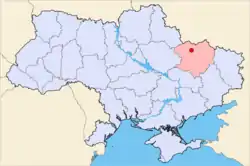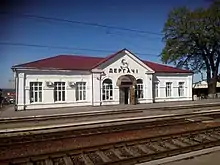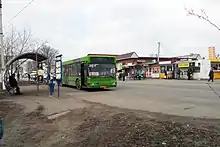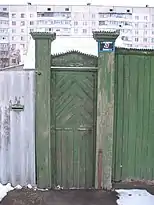Derhachi
Derhachi (Ukrainian: Дергачі́, pronounced [derɦɐˈtʃi]; Russian: Дeргaчи, romanized: Dergachi) is a town in Kharkiv Oblast (province) of eastern Ukraine. It is the administrative center of Derhachi Raion (district), and is located 12 km (7 mi) northwest of the oblast capital, Kharkiv. The settlement was founded in the second half of the 17th century as a sloboda. Population: 17,655 (2020 est.)[1]
Derhachi
Дергачі Dergachi | |
|---|---|
 Coat of arms | |
 Map of Ukraine with Derhachi highlighted | |
| Coordinates: 50°07′N 36°07′E | |
| Country | |
| Area | |
| • Total | 19.1 km2 (7.4 sq mi) |
| Elevation | 122 m (400 ft) |
| Population (2020) | |
| • Total | 17,655 |
| • Density | 920/km2 (2,400/sq mi) |
| Time zone | UTC+2 (EET) |
| • Summer (DST) | UTC+3 (EEST) |
| Postal code | 62309 |
| Area code(s) | +380 5763 |
The name
There are at least two versions of the origin of the town name. The first one is connected with derkach — the Ukrainian name of a corncrake that inhabits the banks of the local Lopan river. Another version appeals to the name of the legendary cossack Derkach who is considered to be the founder of the town. Since 1943, the Soviet local authorities have rejected the Ukrainian variant of the name Derkachi (with letter k) and began to use only the Russian one — Derhachi (with letter h). Later the russian pronunciation was installed in Ukrainian official settlements classification.
Geography
Location
.jpg.webp)
The town lies in a valley on the Lopan river north west to the second largest Ukrainian city Kharkiv. The most part of the town is plain and located on the left bank of Lopan. The western edge of the settlement is hilly and full of ravines. The riverbed of Lopan has many artificial channels and small tributaries in this place. The regional road T2103 goes through the town from north west to south east and connects it with Kharkiv and Zolochiv. There is a significant uninhabited forested area south west to the town.
Climate
Derhachi has humid continental climate, Dfb by Köppen climate classification with warm summer but there is no dry season. The average annual temperature is 7.3 °C. The rainfall here is around 535 mm per year. [2]
History
Scythian ages
It is scientifically proved that territory of nowadays Derhachi was populated in Scythian times (6 — 3 centuries B.C.) and later.[3] A unique Scythian ritual pommel decorated with a sphinx was found at the town.[4] This artifact was a part of Scythian World Tree and now it is exhibited in Kharkiv Historical Museum. In 2018 and 2019, the archaeological expedition of the Kharkiv Historical Museum carried out excavations of the Scythian kurgan in western part of the town. The scientists explored the mounds and received a collection of items with information on the funeral rite of scythian times.[5]
Cossacks era
In the 17th century Derkachi was a sotnia town of the Kharkiv Sloboda Cossack Regiment. Up to the 1742 there was one cossacks sotnia administration, in 1742—1765 — two sotnia administrations. Traditionally a sotnyk (head of a sotnia) in Derkachi was a member of well known in Sloboda Ukraine Kowalewski family (Dołęga coat of arms). The town had its own symbols. The sotnia standard had an image of the archangel Michael. The town seal contained an image of a derkach bird (corn crake) with an octagram above it. According to the 1779 documents Derkachi was a military sloboda of the Kharkiv povit (uyezd) with a population of 2287 citizens. [6]
Russian empire
It was a settlement in Kharkov Governorate of the Russian Empire.
Holodomor
At least 274 of town residents have died because of Holodomor, man-made famine in Soviet Ukraine in 1932 and 1933.[7] [8] The officials of Derkachi town council were involved in expropriation of local citizens property in 1932. [9]
Second World War
During German-Soviet War the town was occupied by the Wehrmacht for 630 days, from October 21, 1941 till August 13, 1943 excluding short brake from February 13, 1943 till March 10, 1943 (while the Third Battle of Kharkov).[10] In those days nazi have established Derkachi town council (Ukrainian: Деркачі́вська міська рада; German: Dergatschi Gemeindeverwaltung), a local government body with at least 21 local residents hired as a stuff. One of the main activities of the council was to provide labor at the request of the occupation authorities.[10]
City since 1977.[11]
Independent Ukraine (since 1991)
In January 2013 the population was 18 154 people.[13]
Transportation
Trains

The town has 3 railway stops operated by Ukrainian Railways: Derhachi,[11] Motorna and Novi Derhachi. The largest stop Derhachi has a station building. All stops are used only by commuter trains running on the line Kharkiv - Kozacha Lopan. Before russian military intervention there was a direct commuter train connection with towns in Belhorod oblast of Russia.
Buses

Derhachi has a bus connection with the city of Kharkiv. The buses on this route go via the central street Sumsky Shliakh, then follow through the town of Mala Danylivka to the center of Kharkiv (bus station Tsentralnyi Rynok).
The town also has an internal bus route, which mainly runs along the central streets (Sumskyi Shliakh and Zolochivskyi Shliakh). The town also has direct connection with neighboring raion center Zolochiv.
Metro
In the 1980s, when planning the Oleksiivska line of the Kharkiv Metro, the construction of the metro station 'Dergachi' was planned, but the station has not been built yet.
Economy
The majority of enterprises are concentrated in the industrial zone in the south of the town near the Motorna railway stop.
The largest enterprises that have production in the town are:
The town is a manufacturing base of the BRIG company which is one of the world's leading manufacturers of rigid-hulled inflatable boats.[16]
Notable people
Born in the town
- Panas (Afanasi) Matushenko — leader of the mutiny on the russian battleship Potemkin in 1905.
Lived or worked in the town
- Hnat Khotkevych — Ukrainian writer, ethnographer, composer, and bandurist. As a student in 1895, organized a village theater in Derkachi. In 1920-1928 taught Ukrainian language and literature in the Derkachi zoo technical school
- Oleksandr Oles — Ukrainian writer and poet. In 1893 he entered the farming school in Derkachi, where he published the first verses.
Media
In Soviet times the town had a newspaper established in 1939 by the local Communist Party committee.
The newspaper changed its name continuously:[17]
- By the way of Stalin (Ukrainian: Сталінським шляхом), 28 July 1939 — 4 November 1956
- The truth of Lenin (Ukrainian: Ленінська правда), 1957 — 1962
- The tribune of the working people (Ukrainian: Трибуна трудящих), 1962 — 1967
- The way of Lenin (Ukrainian: Ленінський шлях), 1967 — 10 October 1991
- The news of Derhachi land (Ukrainian: Вісті Дергачівщини), since 10 October 1991
Image gallery
 Old wooden gates in Derhachi
Old wooden gates in Derhachi
References
- "Чисельність наявного населення України (Actual population of Ukraine)" (PDF) (in Ukrainian). State Statistics Service of Ukraine. Retrieved 30 September 2020.
- "Derhachi climate: Average Temperature, weather by month, Derhachi weather averages - Climate-Data.org". en.climate-data.org. Retrieved 2020-05-12.
- "Пам'ятки археології Дергачівського району", Вікіпедія (in Ukrainian), 2013-01-24, retrieved 2020-01-12
- Іванович, Бабенко Леонід (1998). "Скифское бронзовое навершие из собрания Харьковского исторического музея". Cite journal requires
|journal=(help) - Декабря, 14; До 60-річПрес-релізОтветить, 2018 в 6:55 дп Проблеми історії та археології України: Матерали ХІ Всеукраїнської наукової конференції «Проблеми історії та археології України (2018-12-13). "Прес-реліз: Презентація виставки "Підсумки польових досліджень 2018 року"". Харьковское областное историко-археологическое общество (in Russian). Retrieved 2020-01-12.CS1 maint: numeric names: authors list (link)
- Opysy kharkivsʹkoho namisnyt︠s︡tva kint︠s︡i︠a︡ XVIII st. Pirko, V. O., Hurz︠h︡iĭ, O. I. (Oleksandr Ivanovych), Sokhanʹ, P. S. (Pavel Stepanovich). Kyïv: Nauk. dumka. 1991. ISBN 5-12-002041-0. OCLC 28426738.CS1 maint: others (link)
- Національна Книга пам′яті жертв Голодомору 1932–1933 pp. в Україні. Харківська область. Kharkiv: Фоліо. 2008. pp. 690–696. ISBN 978-966-03-4660-4.
- "Деркачівський мартиролог (з Національної книги пам'яті жертв Голодомору в Україні)". history.derkachi.pp.ua. Retrieved 2020-02-18.
- "Хроніки Голодомору у Деркачах (1932). Деркачівська сільрада відмовляється повернути майно селянам: "Заяву залишити без наслідків..."". history.derkachi.pp.ua. Retrieved 2020-02-18.
- "Деркачі під німецькою окупацією: органи влади". history.derkachi.pp.ua. Retrieved 2020-02-18.
- Дергачи // Большой энциклопедический словарь (в 2-х тт.). / редколл., гл. ред. А. М. Прохоров. том 1. М., "Советская энциклопедия", 1991. стр.376
- Всесоюзная перепись населения 1989 г. Численность городского населения союзных республик, их территориальных единиц, городских поселений и городских районов по полу
- Чисельність наявного населення України на 1 січня 2013 року. Державна служба статистики України. Київ, 2013. стор.98
- "Contacts". UBC retail. Retrieved 2019-03-17.
- "Amcor Rentsch builds cigarette packaging plant". www.tobaccojournal.com. Retrieved 2019-03-17.
- Mitrofanova, Anastasia (2016-03-21). "Kharkiv aviators conquer the world market of high-speed boats". The Kharkiv Times. Retrieved 2019-03-17.
- Газеты СССР 1917-1960. Библиографический справочник. В 5 т. Т.3. (Краевые, губернские, областные, окружные, уездные, районные, городские, транспортные, военные и другие газеты). Moscow: Книга. 1978. p. 362.
| Wikimedia Commons has media related to Derhachi. |